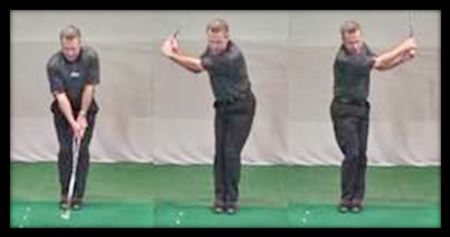There are no shortcuts to better ball-striking – so ended last week’s epistle. While that statement is true, there are certain drills that can offer an insight, and feel, into what it’s like to actually hit the ball “square”. For those who have never experienced the sensation of a “full shot flushed square to target” let me assure you, it’s better than sex!
Before we go there I will resate something written previously: I am not a certified golf instructor, nor do I claim that advice offered in these columns cures all problems. Ideas presented here are based primarily upon my own humble (amateur) experiences augmented by copious reading on matters golf. If you, the reader, really want to improve your ball-striking, you probably can’t avoid hitting balls, visiting a professional teacher and hitting more balls – about one range-hour for each minute of instruction. This should suit those in Pattaya down to a tee – I mean what else is there to do?
 The feet-together drill – creating an in-to-in swing path.
The feet-together drill – creating an in-to-in swing path.
Last week’s column focused on clubface alignment and swing-paths, pointing out that the vast majority of us hopeless golf romantics actually slice the ball. We do this because our swing-path is out-to-in; where the club approaches the ball from outside the target line and travels across the line to the inside after impact. This results in a wide left-to-right (for right-handers) ball flight which not only finishes off target, but lacks length, significantly so.
Three fundamental elements of hitting a golf ball are grip, stance and swing. Whilst each one of these is a subject in itself, this article will assume your grip and stance is sufficiently proficient to complete the swing mechanics necessary to rotate the club.
Put aside a few hours at your local driving range. You will need a couple of trays of balls, a 7-iron, an open mind and some patience. Descriptions apply to right-handers.
Without ball, take a normal stance then put feet together with elbows tucked in, as in the address position, above. With light grip pressure, swing back easily with your upper arms brushing your chest as your wrists start to hinge.
Stop when your left arm is horizontal to the ground (9 o’clock), as shown in centre photo, but elbow straight.
Note the position of the back of your left hand – it should be facing frontwards, towards the target.
Keeping your upper arms close to your chest, swing the club slowly (no ball yet) down through the impact area and on to where your right arm is horizontal to the ground (3 o’clock), elbow straight. The back of your left hand should now be facing the ground.
Repeat this 9-to-3 movement a few times and watch what happens to your wrists – they rotate. Most golfers with medium to high handicaps don’t rotate – ball-strikers do. This rotation is not caused by conscious thought. Rather, it is the result of swinging from 9 to 3 around a stationary spine. During the full golf swing, club-head rotation is further aided by the weight of the head relative to the far lighter shaft – provided the golfer’s grip is not overly tight.
After several practise swings you will feel your balance improve. Your feet are together to limit your swing. Bad balance will be due to over-swinging. This exercise is not about smashing the ball; it’s about achieving the correct swing-path whilst maintaining balance and rhythm.
Now, align the club-head on to a target, address the ball (teed up) and hit with half-power. When you sense your balance is being maintained, increase to three-quarter power. Your focus should be on maintaining balance, rhythm and making good contact. After some practise, you may wish to swing past 3 o’clock – not a problem. But never take the backswing past 9 o’clock.
Don’t expect to master this in five minutes, but persevere and master it you will. At a point when your ball-contact is good on say seven from ten attempts, start swinging with as much power as good balance permits – keeping both feet firmly planted and together.
It’s about now you medium to high-markers will notice when contact is flush, the ball literally soars – even past where your normal 7-iron would finish – the feel from your hands will be as if you hardly touched it, and all this from a half-swing!
Something else has been introduced that high-markers normally keep suppressed; the posture of feet-together coupled with upper-arms close to chest promotes a natural release. It’s caused by those wrists rotating – the later the better. This and the in-to-in swing path the drill promotes results in the shot being hit square-to-square (straight), or square-to-out (draw), the pre-requisite for better ball-striking. Whilst this may not be orgasmic, we’re not far away.
Next week – “It’s better than sex.”
Golfnutter




